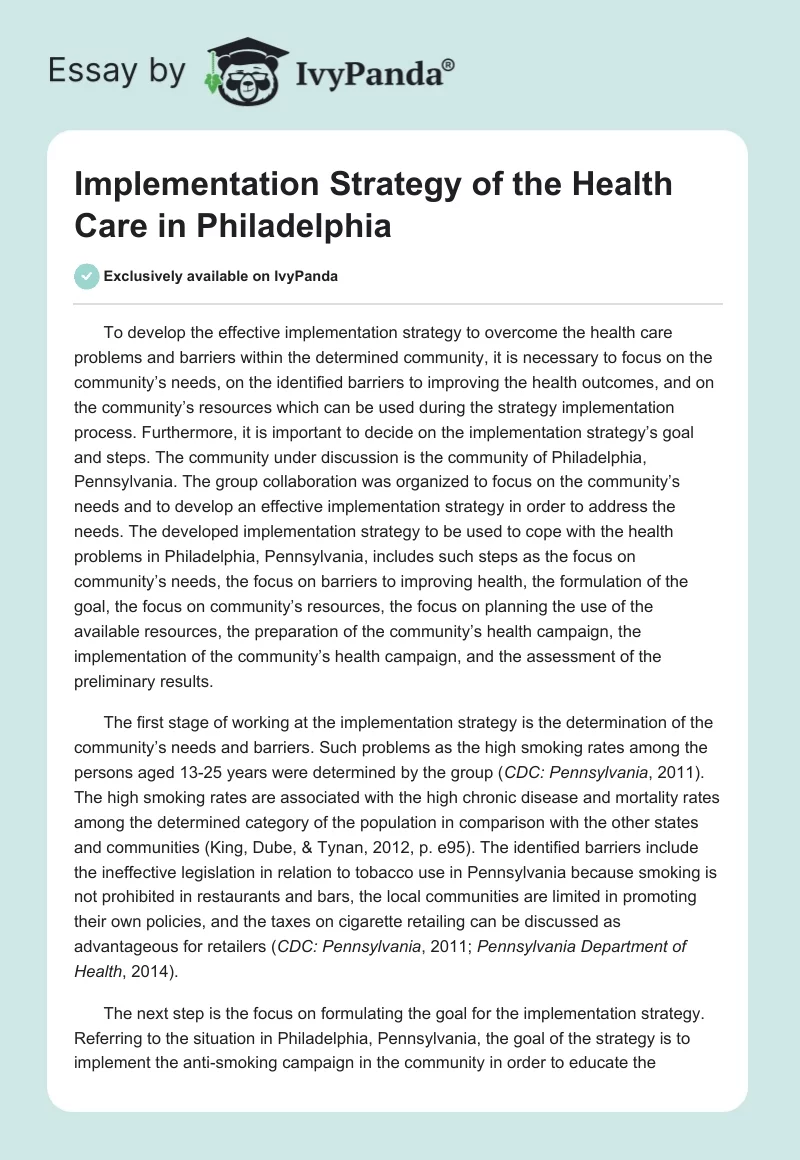To develop the effective implementation strategy to overcome the health care problems and barriers within the determined community, it is necessary to focus on the community’s needs, on the identified barriers to improving the health outcomes, and on the community’s resources which can be used during the strategy implementation process. Furthermore, it is important to decide on the implementation strategy’s goal and steps. The community under discussion is the community of Philadelphia, Pennsylvania. The group collaboration was organized to focus on the community’s needs and to develop an effective implementation strategy in order to address the needs. The developed implementation strategy to be used to cope with the health problems in Philadelphia, Pennsylvania, includes such steps as the focus on community’s needs, the focus on barriers to improving health, the formulation of the goal, the focus on community’s resources, the focus on planning the use of the available resources, the preparation of the community’s health campaign, the implementation of the community’s health campaign, and the assessment of the preliminary results.
The first stage of working at the implementation strategy is the determination of the community’s needs and barriers. Such problems as the high smoking rates among the persons aged 13-25 years were determined by the group (CDC: Pennsylvania, 2011). The high smoking rates are associated with the high chronic disease and mortality rates among the determined category of the population in comparison with the other states and communities (King, Dube, & Tynan, 2012, p. e95). The identified barriers include the ineffective legislation in relation to tobacco use in Pennsylvania because smoking is not prohibited in restaurants and bars, the local communities are limited in promoting their own policies, and the taxes on cigarette retailing can be discussed as advantageous for retailers (CDC: Pennsylvania, 2011; Pennsylvania Department of Health, 2014).
The next step is the focus on formulating the goal for the implementation strategy. Referring to the situation in Philadelphia, Pennsylvania, the goal of the strategy is to implement the anti-smoking campaign in the community in order to educate the community members about the health outcomes of smoking and to contribute to decreasing the number of smokers among the 13-25-years-old population and to decreasing the rate of chronic diseases associated with tobacco use and the rate of mortality among the 13-25-years-old population.
While focusing on the community resources, it is necessary to plan their use in the local anti-smoking campaign. It was noted during the group’s meeting that it could be important to focus on the available statistical data to use the materials in the anti-smoking campaign posters and to cooperate with the local medical centers (Green & Tones, 2010, p. 421-423).
The next determining step is the preparation of the community’s anti-smoking campaign. The process should include the analysis of the statistical data on the mortality and chronic disease rates, the development of diagrams and tables, the composition of the posters. The implementation of the anti-smoking campaign is the next step which includes the distribution of the posters in the local medical centers (Novick, Morrow, & Mays, 2008, p. 112). The assessment of the preliminary results is planned to be realized with the help of conducting the interviews and analyzing the community members’ answers.
It is possible to state that the chosen implementation strategy for coping with the community’s health problems is also correlated with the elements of the education intervention which is based on the idea that the community should be educated in relation to the health outcomes of such habits as smoking.
References
CDC: Pennsylvania. (2011). Web.
Green, J., & Tones, K. (2010). Health promotion: Planning and strategies. Thousand Oaks, CA: Sage.
King, B., Dube, S., & Tynan, M. (2012). Current tobacco use among adults in the United States: Findings from the National Adult Tobacco Survey. American Journal of Public Health, 102(11), e93-e100.
Novick, L., Morrow, C., & Mays, G. (2008). Public health administration: Principles for population-based management. USA: Jones and Bartlett Publishers.
Pennsylvania Department of Health. (2014). Web.


